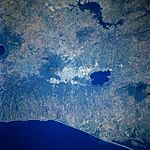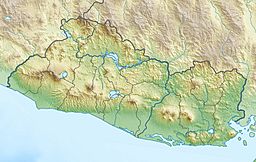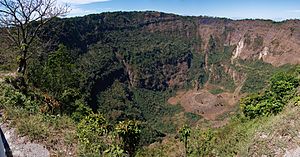San Salvador (volcano) facts for kids
Quick facts for kids San Salvador Volcano (Quezaltepeque) |
|
|---|---|

The San Salvador volcano is instantly recognizable by its distinctive triangular crescent pointed apex, which has a dorsal fin-like shape.
|
|
| Highest point | |
| Elevation | 1,893 m (6,211 ft) |
| Geography | |
| Geology | |
| Mountain type | Stratovolcano |
| Last eruption | June to November 1917 |
The San Salvador Volcano (also known as Quezaltepeque or El Boquerón) is a stratovolcano situated northwest to the city of San Salvador. The crater has been nearly filled with a relatively newer edifice, the Boquerón volcano. San Salvador is adjacent to the volcano and the western section of the city actually lies among its slopes. Due to this close proximity, any geological activity of the volcano, whether eruptive or not, has the potential to result in catastrophic destruction and death to the city. Despite this, the volcano is iconic of the city, and several TV and radio antennas are situated on the El Picacho peaks and the crater of Boqueron. El Picacho, the prominent peak is the highest elevation (1,960 meters altitude).
Boquerón edifice


The main edifice, known as the Boquerón edifice, formed between 700 and 1,000 years ago, filling up a former caldera. The crescent-shaped ridge on the northeast side of the volcano is a remnant of the caldera rim. The lavas of the Boquerón edifice contain more alkali elements and iron oxide than the lavas of the older edifice. Around 800 years ago, the present day crater was formed in a violent explosion. The crater, which gives it the present name (Boquerón means "big mouth" in Spanish) is 1.5 km in diameter and 500m deep. Within the crater around the upper walls, crops are cultivated by the locals who live on the volcano.
The magma chamber which the volcano sits upon contains a number of fissures which protrude along the flanks and sides of the volcano. The northwest (N40W) fissure has been the most active recently, with such significant eruptive events, such as the Loma Caldera eruption which buried the ancient village of Ceren and the eruption of El Playon (1658–71) which buried the town of Nexapa. The citizens relocated to Nejapa and nowadays the eruption is celebrated annually.
The most recent eruption in 1917 caused a flank eruption on the volcano along the N40W fissure. During this eruption, the crater lake inside the Boquerón evaporated and a cinder cone appeared, christened 'Boqueroncito'.
Gallery
See also
 In Spanish: Volcán de San Salvador para niños
In Spanish: Volcán de San Salvador para niños
- List of volcanoes in El Salvador










